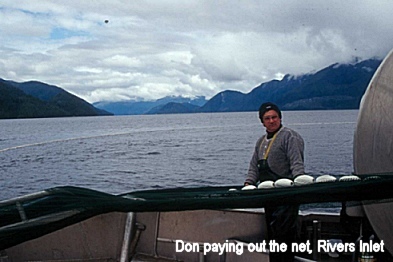
|
|||||||||||
 |
Introduction to the ProjectRivers and Smith
Inlet sockeye salmon (Oncorhynchus nerka) originate from two large
lakes on the Central Coast of British Columbia (see maps).
Together, these two salmon populations made up one of the three
largest salmon runs in the province. The returning adult fish were
the mainstay of the diet and economy for the Owikeno and Gwa’sala
First Nations. In the late 1800's, the commercial fishery exploded
and the region supported 12 canneries at its height. However, fish
population |
Several studies have considered various possible reasons, but have met with only limited success. Rivers Inlet sockeye salmon spawn in Owikeno Watershed, and although the area has been extensively logged, lake surveys indicate that fry abundance remained high until very recently. Results of an experiment in adaptive fisheries management and more recent fisheries restrictions also argue against the direct effects of overfishing. The population is obviously suffering substantially increased mortality at some later stage in its life cycle. Available evidence for Smith Inlet sockeye salmon, which spawn in the Long Lake Watershed, appears also to point to increased marine mortality. As further evidence for this claim, sockeye salmon smolts leaving Owikeno Lake have also traditionally been extraordinarily small, the smallest smolt in northwestern North America according to one recent study. Research elsewhere has demonstrated that small smolts are more likely than larger ones to perish at sea early in their life cycle.
Indeed, the limited research to date points to a major increase in marine mortality. In addition, our field research in 2002 showed that migrating juvenile sockeye salmon made considerable use of both Rivers Inlet and a smaller fjord in Smith Inlet. Both of these were covered by a surface layer of fresh to brackish water. This habitat is potentially vital to these fish as they acclimatize to salt water. Yet hydrological and other data suggest that major changes may have occurred to the surface layer which could have substantially reduced the sockeye salmon food supply in this critical habitat. These include changes to the annual cycle of depth and turbidity associated with climate change and reductions in the nutrient supply to these waters. These latter changes are in turn associated with both (i) the interception and export of marine nutrients from commercial fishing and (ii) changes to coastal ocean circulation patterns.
Our overarching goal is to determine what caused the rapid decline in the Rivers and Smith Inlets sockeye populations. We will use sediment coring to assess potential reductions to marine-derived nutrients and associated changes to lake and inlet ecology, and hydrodynamic modelling to assess potential changes to the freshwater surface layer associated with past and possible future atmospheric and oceanographic changes (e.g. consequences of global warming). Please read on to learn more about the specifics of the project -- return to Rivers Inlet Project Main Page and click on the links at the left-hand side of the page.